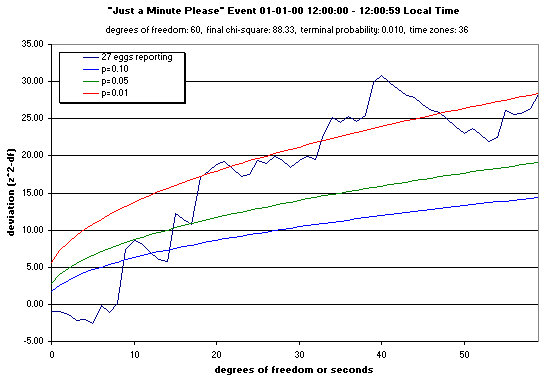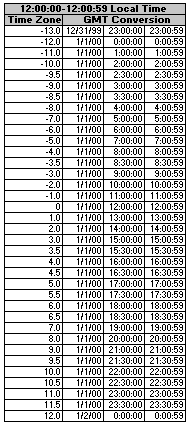Just a Minute Please |
|
Formal AnalysisIn addition to the actual transition to the New Year at midnight on the 31st of December, other events had been planned and publicized in various ways to take advantage of the focusing power of the Year 2000 celebrations. All around the world, efforts were made to organize large numbers of people to meditate or pray for peace. Most were timed for the big Y2K midnight, but one meditation event was planned for 12:00 noon on the first day of the new millennium, 1 January, 2000. Called "Just a Minute Please", this invitation to envision a positive future was widely publicized in religious and secular venues including the internet, and was sponsored by the Global Consciousness Project. The idea was developed by Chino Srinivasan, who hosts a GCP egg, and he promoted the event with well placed energy, for example, communicating it to the Dalai Lama, who recommended Just a Minute to his followers, and led the meditation in the Temple of the "Golden Buddha" in Sarnath, India. The time defined for the GCP analysis of the JAM event was from 12:00 to 12:01 in every time zone. The assessment method chosen was an epoch analysis, in which the data were averaged across all timezones and all eggs, and then converted to a Chisquare (Z²) for each second. This is a variation on the usual GCP analysis, reflecting in part the analysis strategy developed by Dean Radin for the Y2K event. The present analysis is simpler, however, and uses the mean (not the median) of the raw data without smoothing. The outcome is finally displayed as a cumulative Chisquare, which clearly shows a consistent increase in the magnitude of score deviations during the specified time. A complete, detailed description of the procedure is given below. George deBeaumont performed the analysis shown here, integrating the data as described. Note that there are more time zones than the 24 we tend to envision; in George's description: Sometimes, it's hard to determine the parameters for an analysis. Whether or not to include the odd time zones is one of those issues. While it's certainly more convenient to just use 24 one hour increments, some of the other time zones (besides India) turn out to have significant population centers: +3:30 Newfoundland, Canada -3:30 Tehran, Iran -4:30 Kabul, Afghanistan -6:30 Rangoon, Burma -9:30 Darwin, Australia This may have bearing upon the initial Y2K rollover analyses. So, I decided to bite the bullet and use the 36 time zones. The following figure incorporates data from all time zones and all 27 eggs that had reported data as of 11 January. The cumulative deviation averaged across all time zones and all eggs yields a Chisquare of 88.33 on 60 df, with a probability against chance of 0.010. Below the figure is a table documenting the 36 time zones used in the analysis, expressed in the time zone offset and the actual GMT times of the Just a Minute event.

Table of Time Zones for "Just a Minute Please"
Here is a stepwise description of the analysis procedure by George deBeaumont:
The basic steps of any analysis are:
1) Normalize (that is, mean of 0 and variance of 1) as a Z score:
Z = (observed - expected)/standard deviation
theoretical mean of one trial: 100 (200 bits at p=0.5)
theoretical standard deviation: sqrt(50) = 7.071
2) Square Z, (Z^2 = the chi-square random variable).
This has a different probability density function than the normal
distribution (e.g., values can't be less than 0; mean is equal to degrees of
freedom).
3) The chi-square values can be added together. We then have a series of
summed chi-squares with an associated n degrees of freedom.
4) Subtract the degree of freedom (df) associated with each summed
chi-square ((z^2)-df) so that the expectation for the cumulative deviation
is now zero. This value ((z^2)-df)is plotted against its associated df.
|
